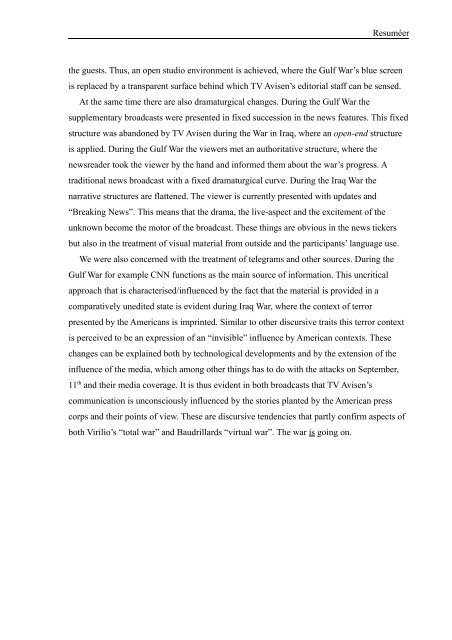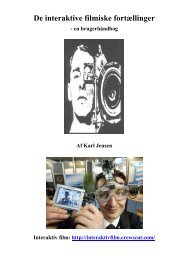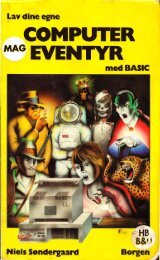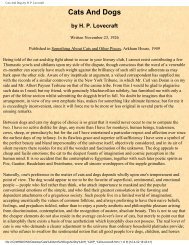Krig, medier og individ - NotatWiki
Krig, medier og individ - NotatWiki
Krig, medier og individ - NotatWiki
Create successful ePaper yourself
Turn your PDF publications into a flip-book with our unique Google optimized e-Paper software.
Resuméer<br />
the guests. Thus, an open studio environment is achieved, where the Gulf War’s blue screen<br />
is replaced by a transparent surface behind which TV Avisen’s editorial staff can be sensed.<br />
At the same time there are also dramaturgical changes. During the Gulf War the<br />
supplementary broadcasts were presented in fixed succession in the news features. This fixed<br />
structure was abandoned by TV Avisen during the War in Iraq, where an open-end structure<br />
is applied. During the Gulf War the viewers met an authoritative structure, where the<br />
newsreader took the viewer by the hand and informed them about the war’s pr<strong>og</strong>ress. A<br />
traditional news broadcast with a fixed dramaturgical curve. During the Iraq War the<br />
narrative structures are flattened. The viewer is currently presented with updates and<br />
“Breaking News”. This means that the drama, the live-aspect and the excitement of the<br />
unknown become the motor of the broadcast. These things are obvious in the news tickers<br />
but also in the treatment of visual material from outside and the participants’ language use.<br />
We were also concerned with the treatment of telegrams and other sources. During the<br />
Gulf War for example CNN functions as the main source of information. This uncritical<br />
approach that is characterised/influenced by the fact that the material is provided in a<br />
comparatively unedited state is evident during Iraq War, where the context of terror<br />
presented by the Americans is imprinted. Similar to other discursive traits this terror context<br />
is perceived to be an expression of an “invisible” influence by American contexts. These<br />
changes can be explained both by technol<strong>og</strong>ical developments and by the extension of the<br />
influence of the media, which among other things has to do with the attacks on September,<br />
11 th and their media coverage. It is thus evident in both broadcasts that TV Avisen’s<br />
communication is unconsciously influenced by the stories planted by the American press<br />
corps and their points of view. These are discursive tendencies that partly confirm aspects of<br />
both Virilio’s “total war” and Baudrillards “virtual war”. The war is going on.





